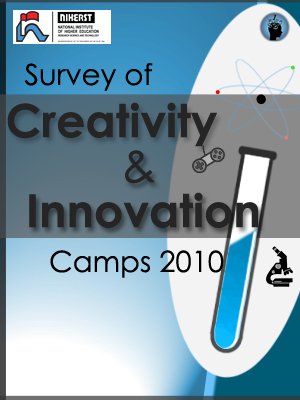
NIHERST conducted a tracer study of its annual July/August Creativity & innovations camps in March, 2010. These camps are designed to engage and develop young minds within the field of science and technology and to develop the creative and innovative capabilities of youngsters.
The study's sampling frame contained a total of 1052 participants who enrolled in the following four camps, Funology (5-7 years), Explorer (8-12 years), Young Inventors (13-17 years), and Robomania (13-17 years), over the period 2004 to 2009. Of the total participants, 310 or 30% were surveyed, and 227 or 73% responded.
Summary of Main Findings
Data Highlights
- During the period 2004 to 2009, half (51%) of the responding sample of campers (227) attended the Explorer camps while 30% attended Funology, 15% Young Inventors, and 4% Robomania - the newest in the creativity and innovation camps.
- Of the total campers, 37% were females and 63% were males.
- The vast majority of parents (94%) found that the camps encouraged positive social interactions between their children and their peers. This was so for both genders.
- The camps had a positive impact on campers' interest in science (95%), educational development (96%), and social development (96%).
- Two-thirds (66%) of the campers independently expressed an interest in professions in science and/or technology.
- The creativity & innovations camps improved peer interaction (62%), leadership abilities (56%), confidence (70%), and attitude towards school (64%) in a substantial proportion of campers.
- For 57% of the participants the activities at camps had a positive impact on school grades particularly with respect to science subjects.
- One-half (50%) of the campers benefited from a competitive edge over peers who did not attend the camp.
- Most of the participants were encouraged to use the knowledge gained to solve common problems.
- A significant percentage (85%) indicated that the camp environment was conducive to achieving desired goals.
- A significant percentage of respondents agreed that camps should be expanded to include more details of the school curriculum.
- After experiencing the alternative teaching methods used in the camps, the vast majority (94%) agreed that more interactive and creative learning techniques should be implemented in the school curriculum. The major reasons advanced were the benefit of an increase in knowledge, exposure to different learning methods, a stimulating environment and an increase in interest in science.
- The majority of parents (96%) felt that the creativity and innovation camps should be implemented in other areas of education, such as the Arts and Humanities.
- One-quarter of the respondents highlighted educational development (26%) and an increased exposure to science (25%) as the major benefits of a nationwide programme of creativity and innovation camps.
- Educational experience and fun were stated as the primary reasons for children returning to the camps, which were also identified as an exciting option by parents when planning vacation activities.






